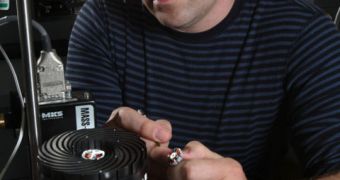Engineers at the Sandia National Laboratories (SNL) say they've created an innovative cooling device, that could be used to improve heat transfer for microelectronic devices or other cooling applications.
The laboratories, which are managed by Lockheed Martin's Sandia Corporation, are a leading source of innovative research in computing and microelectronics. The new air-cooling technology could dramatically change the existing industry.
At this point, SNL officials are involved in an effort to license and commercialize the device, in order to bring it to the electronics chip cooling field as soon as possible. The instrument has been dubbed the Air Bearing Heat Exchanger or, more simply, the Sandia Cooler.
The research team that created the new device was led by Sandia expert Jeff Koplow. He was recently selected to take part in the17th annual US Frontiers of Engineering symposium, which is organized by the National Academy of Engineering. NAE also selected the expert for participation.
At first, the new device will be oriented towards industrial applications, such as data centers and large-scale computing environments, while future versions are expected to be scaled down for use at home.
It is estimated that the widespread adoption of this new technology would save a huge chunk of the $7 billion electricity bill that the US IT sector gets every single year. In the next couple of decades, the bill is expected to rise as more advanced computers will require even more current.
“In a conventional CPU cooler, the heat transfer bottleneck is the boundary layer of “dead air” that clings to the cooling fins. With the Sandia Cooler, heat is efficiently transferred across a narrow air gap from a stationary base to a rotating structure,” a SNL press release reports.
“The normally stagnant boundary layer of air enveloping the cooling fins is subjected to a powerful centrifugal pumping effect, causing the boundary layer thickness to be reduced to ten times thinner than normal,” the document goes on to say.
Using the Sandia Cooler, it is possible to improve cooling performances beyond anything possible with existing technologies, while at the same time benefiting from this capability in a small package.
“The Sandia Cooler also offers benefits in other applications where thermal management and energy efficiency are important, particularly heating, ventilation and air-conditioning (HVAC),” the release explains.

 14 DAY TRIAL //
14 DAY TRIAL //